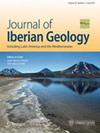西班牙东北部Blesa组(下白垩纪)蜥脚类动物的古生物多样性
IF 1.5
4区 地球科学
Q2 GEOLOGY
引用次数: 0
摘要
Blesa地层是伊比利亚半岛Barremian地区脊椎动物生物多样性最丰富的地层之一。在La Cantalera-1遗址中发现了32种以上的脊椎动物分类群,但唯一的蜥脚类动物遗骸是与真足科有关的三颗孤立的牙齿。本文综述了迄今为止在该地层中发现的所有蜥脚类动物化石,并介绍了新的化石。这些材料来自Blesa组三个沉积序列的不同地点。在La Cantalera-1遗址发现了一颗新牙、一段颈椎和一段尾椎,并初步归属于真足科。分别在Blesa序列的下、中、上三个序列的不同化石地点发现了左胫骨、左坐骨和尾椎。这些新的蜥脚类恐龙遗骸属于雷龙目,这是伊比利亚半岛巴雷米亚最常见的恐龙群。化石的孤立特征妨碍了更精确的分类归属。本文章由计算机程序翻译,如有差异,请以英文原文为准。
Paleobiodiversidad de Sauropoda en la Formación Blesa (Cretácico Inferior) en el noreste de España
Abstract The Blesa Formation is one of the richest formations of the Barremian of the Iberian Peninsula in terms of vertebrate biodiversity. In the La Cantalera-1 site more than 32 vertebrate taxa have been identified, but the only sauropod remains are three isolated teeth related to Euhelopodidae. In this paper, all the sauropod material studied so far in this formation is reviewed and new remains are described. The material comes from different sites in all three depositional sequences of the Blesa Formation. A new tooth, a fragmented cervical vertebra and a caudal vertebra are described in the La Cantalera-1 site and assigned tentatively to Euhelopodidae. One left tibia, one left ischium and one caudal vertebra have been recovered in different fossils sites in the Lower, Middle and Upper Blesa sequences respectively. These new sauropod remains are assigned to Titanosauriformes, the most common group of dinosaurs in the Barremian of the Iberian Peninsula. The isolated character of the fossils precludes more precise taxonomic attributions.
求助全文
通过发布文献求助,成功后即可免费获取论文全文。
去求助
来源期刊

Journal of Iberian Geology
地学-地质学
CiteScore
2.60
自引率
7.70%
发文量
18
审稿时长
>12 weeks
期刊介绍:
The Journal of Iberian Geology will consider for publication original, high-quality papers (including research articles, reviews and brief communications) dealing with different aspects of Earth Sciences in Latin America and the Caribbean, as well as the Mediterranean region, including Geology, Paleontology, Geophysics and Geochemistry. The journal welcomes research papers with regional appeal, but these should present results of international interest. The Journal accepts collections of selected original papers on topics within these scopes, which will be published as edited monographic issues.
 求助内容:
求助内容: 应助结果提醒方式:
应助结果提醒方式:


